 INSTALLATION AND OPERATION
INSTALLATION AND OPERATION
USER MANUAL
WWW.UNICORECOMM.COM
UM220-IV L
Single Frequency Multi-GNSS
Timing Module
UM220-IV L Single Frequency Multi GNSS Timing Module
Copyright© 2009-2023, Unicore Communications, Inc.
Data subject to change without notice.
Revision History
| Version | Revision History | Date |
| R1 | Initial version | 2020-01-06 |
| R1.1 | Update the range of VCC and V_BCKP | 2021-08-31 |
| R1.2 | Add notes in Section 4.2 | 2021-11-17 |
| R1.3 | If hot start is not used, connect V_BCKP to VCC. Revise the VSWR in Table 1-2 |
2022-11-29 |
| R1.4 | Optimize Chapter 4.2 Antenna Design; Optimize Chapter 4.1 Power Supply |
2023-04 |
Legal right notice
This manual provides information and details on the products of Unicore Communication, Inc. (“Unicore”) referred to herein.
All rights, title and interest to this document and the information such as data, designs, layouts contained in this manual are fully reserved, including but not limited to the copyrights, patents, trademarks and other proprietary rights as relevant governing laws may grant, and such rights may evolve and be approved, registered or granted from the whole information aforesaid or any part(s) of it or any combination of those parts.
Unicore holds the trademarks of “, “UNICORECOMM” and other trade name, trademark, icon, logo, brand name and/or service mark of Unicore products or their product serial referred to in this manual (collectively “Unicore Trademarks”). This manual or any part of it, shall not be deemed as, either expressly, implied, by estoppel or any other form, the granting or transferring of Unicore rights and/or interests (including but not limited to the aforementioned trademark rights), in whole or in part.
Disclaimer
The information contained in this manual is provided “as is” and is believed to be true and correct at the time of its publication or revision. This manual does not represent, and in any case, shall not be construed as a commitments or warranty on the part of Unicore with respect to the fitness for a particular purpose/use, the accuracy, reliability and correctness of the information contained herein.
Information, such as product specifications, descriptions, features and user guide in this manual, are subject to change by Unicore at any time without prior notice, which may not be completely consistent with such information of the specific product you purchase.
Should you purchase our product and encounter any inconsistency, please contact us or our local authorized distributor for the most up-to-date version of this manual along with any addenda or corrigenda.
Foreword
This document describes the product features and information of the hardware design, installation, specification and the use of UNICORECOMM UM220-IV L module.
Audience
This manual is created for the technical personnel, who possess the expertise of GNSS receivers.
Product Introduction
1.1 Overview
UM220-IV L is a GNSS multisystem, high-precision timing module, based on the low power, multisystem, high-performance SoC-UFirebird independently developed by UNICORECOMM. It supports GPS, BDS, GLONASS and Galileo, etc. Moreover, it is capable to receive and process data of two or three systems concurrently, or work on a single system.
UM220-IV L module supports SBAS, QZSS and DGNSS input function, and provides the advanced AGNSS function. It can improve the positioning speed through the assistant data service of UNICORECOMM in the scenario of networking.
With the combined function of filter, linear amplifier and antenna protection, and optimized RF architecture and interference rejection capability, UM220-IV L module provides the reliable performance in complex electromagnetic environments.
UM220-IV L module supports various timing modes including fixed-location timing, optimized-location timing and positioning timing, which ensure the good timing accuracy even in complex signal environmental conditions.
UM220-IV L module features compact dimensions, SMT PADS, full-automatic integration of standard pick-and-place and reflow soldering, and is especially suitable for low-cost, low-power applications. 1.2 Features
1.2 Features
Table 1- 1 Product Feature
| Grade | Size | GNSS | Supply | Interfaces | Features | |||||||||||
| Professional | Automotive | GPS/QZSS | BDS | GLONASS | Galileo | 3.0V | UART1 | UART2 | Antenna Detection | 1PPS | Antenna Feed | Built-in flash | Update Rate | AGNSS | DGNSS | |
| ● | 17x22mm | ● | ● | ● | ● | ● | ● | ● | ● | ● | ● | ● | 1 Hz | ● | ● | |
1.3 Block Diagram
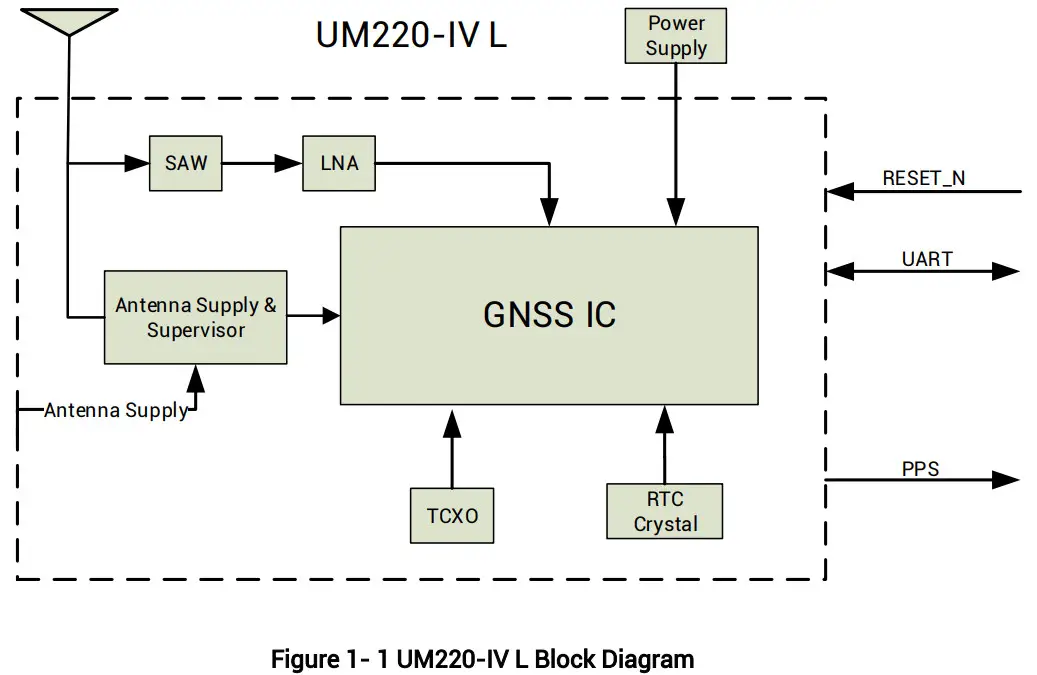
1.4 Performance
Table 1- 2 Specifications
| Power | |||||
| Voltage | 3.0~3.6VDC | ||||
| Power Consumption1 | 62mW @3.3V | ||||
| RF Input | |||||
| VSWR | ≤2.5 | ||||
| Input Impedance | 50Ω | ||||
| Antenna Gain | 5~35dB | ||||
| Physical Characters | |||||
| Dimensions | 17.0mm*22.4mm*2.4mm | ||||
| Weight | 1.7g | ||||
| Environment | |||||
| Operating Temperature | -40℃ ~ +85℃ | ||||
| Storage Temperature | -40℃ ~ +85℃ | ||||
| RoHS2.0 | Compliant | ||||
| Input/ Output Data Interface | |||||
| UART | UART*2, LVTTL. Baud Rate: 4800~115200 bps |
||||
| GNSS Performance | |||||
| Constellations | BDS B1: 1561.098MHZ GPS L1: 1575.42MHZ GLONASS L1OF: 1602MHZ Galileo E1-B/C: 1575.42MHZ |
||||
| TTFF2 (Time to First Fix) | Cold Start: 28s Hot Start: 1s Reacquisition: 1s AGNSS3: 4s |
||||
| Positioning Accuracy (CEP)4 | 2.0m (Horizontal) 3.5m (Vertical) |
||||
| Velocity Accuracy (RMS)5 | 0.1m/s (Horizontal) | ||||
| Sensitivity6 | GPS | BDS | GLONASS | Galileo | |
| Cold Start | -147dBm | -144dBm | -142dBm | -135dBm | |
| Tracking | -160dBm | -160dBm | -158dBm | -154dBm | |
| Continuous positioning, typical value All satellites C/N0 at 41 Assisted data injection in time |
All satellites C/N0 at 41 All satellites C/N0 at 41 Tested with a good external LNA |
| Hot Start | -155dBm | -151dBm | -150dBm | -143dBm | |
| Reacquisition | -155dBm | -151dBm | -150dBm | -140dBm | |
| 1PPS (RMS)7 | 20ns | ||||
| Data Update Rate | 1Hz | ||||
| Format | NMEA 0183,Unicore Protocol,RTCM3.2 | ||||
1.5 Precision Timing and Raw Data Output
UM220-IV L module supports three timing modes: fixed-location timing, optimizedlocation timing and positioning timing. Switch or query the above timing modes throuCFGTM. It can also track all four GNSS systems including GPS, BDS, GLONASS and Galileo, and switch back and forth between these four systems using CFGGNSS.
UM220-IV L module is set to optimized-location timing mode by default, and outputs information of real-time position and site-specific position, which can be queried by TIMPPOS. Refer to UM220-IV L_Protocol Specification for more details.
- Fixed-location Timing
Fixed-location timing mode is applied to static scenes. In this mode, users are required to input the exact position of receiver antenna center through CFGTM manually, which are used by UM220-IV L module to calculate the distance between the antenna and the satellite, and calculate time to perform timing service. - Optimized-location Timing
Optimized-location timing mode is another application used in static scenes. In this mode, the receiver collects a set number of positioning points (within observation time) and calculates the exact position of the antenna. After that, the exact position is locked down, and the timing mode is switched to the fixed-location timing mode.
The observation time and accuracy are configured through CFGTM, but only when both above-mentioned conditions are met to use fixed-location timing mode. Query the observation status through TPFINFO.
The position estimation process is only required once after the UM220-IV L is installed.
When the position optimization is completed, the timing mode set in the receiver automatically switches to the fixed-location timing mode.
7 Open sky
 If the position of UM220-IV L antenna changes, the command CFGTM must be sent again to switch the timing mode back to the optimized position mode to recalibrate the antenna position.
If the position of UM220-IV L antenna changes, the command CFGTM must be sent again to switch the timing mode back to the optimized position mode to recalibrate the antenna position.
Refer to UM220-IV L_ Protocol Specification for more details. - Positioning Timing
Positioning timing is the only timing mode that supports dynamic timing. In this mode, UM220-IV L calculates the antenna position and time in real time. The timing quality depends on the satellite environment, and it is difficult to guarantee the timing accuracy.
1.6 Pulses per Second (1PPS)
UM220-IV L module provides a pulse width output and 1PPS signal of which the pulse polarity is adjustable, and can be configured and queried through CFGTP. TIMTP is used to describe the related 1PPS information including the corresponding time and time accuracy indicators.
1.7 UART
Two UART interfaces are integrated in the UM220-IV L module. UART1 is the master serial port, supports data transmission and firmware upgrade, the I/O signal type is LVTTL. The default baud rate varies according to the version of firmware and the baud rate can be configured by users 8 . Please ensure that UART1 is connected to a PC or external processor to support firmware upgrade. Serial 2 only supports data transmission and is unavailable for firmware upgrade, only for backup.
1.8 Protocol
Table 1- 3 Supported Interface Protocols
| Protocol | Type |
| NMEA0183 | I/O, ASCII, NMEA3.0, NMEA4.1(Default output) |
| Unicore Protocol | I/O, ASCII, Unicore Protocol |
| RTCM⁹ | Input, RTCM3.2 |
8-9 Refer to UM220-IV L_Protocol Specification for more details
1.9 Clock
The industrial TCXO is built into the UM220-IV L module to ensure the stability of the clock system and the ability to capture signals quickly in weak signal environments. UM220-IV L also integrates the 32k crystal to maintain the RTC clock. When the main power supply is removed, the normal operation of the RTC can be maintained by providing V_BCKP.
1.10 Antenna
The filter and linear amplifier are built in the UM220-IV L module. They support active antennas and passive antennas, and the former provides better performance.
Installation
2.1 Prerequisites
Most components on the UM220-IV L module are static sensitive devices (SSD) and require ESD protection for IC circuits and other devices. Perform the following protection measures before opening antistatic plastic boxes.
- Perform the steps in section 2.2 Installation in the correct order;
- Electrostatic discharge (ESD) may cause a damage to the device. All operations referred to in this section should be performed on an ESD workbench using wrist straps and conductive foam pads. If there is no anti-static workbench, wear wrist straps and connect their other ends to the metal frame to avoid electrostatic damages;
- Hold the edge of the module, do NOT touch the components directly;
- Carefully check the module for any apparent loose or damaged components. If there are any questions, please contact Unicore or the local distributors.
Figure 2- 1 Typical Installation of UM220-IV L shows the typical installation of the UM220-IV L EVK.
 Have the following accessories ready before starting the installation:
Have the following accessories ready before starting the installation:
- UM220-IV L EVK (including a power supply)
- UM220-IV L User Manual
- uSTAR_L executable file
- Qualified GNSS antennas
- Antenna cable
- Straight-through cable
- Desktop or laptop computer with serial port and installed with uSTAR_L
![]() Please keep the packing box and anti-static box for storage and handling.
Please keep the packing box and anti-static box for storage and handling.
2.2 Installation
Follow the below steps to install UM220-IV L and EVK.
Step 1. Ensure adequate anti-static measures, such as wrist straps, workbench grounding, etc.
Step 2. Open UM220-IV L EVK suite, and take out the evaluation board.
Step 3. Select the GNSS antenna with the appropriate gain (the system frequency supported by the antenna should be consistent with the module), fix it in the non-occluded area, and use the appropriate cable to connect the antenna and the UM220-IV L EB (evaluation board);
Step 4. Connect the PC to the EVK serial port using a straight-through cable.
Step 5. Power on the evaluation board and initialize UM220-IV L.
Step 6. Open the uSTAR_L software.
Step 7. Configure the receiver through uSTAR to display constellations view, messages, and receiver status, etc.
Technical Specifications
3.1 Electrical Specifications
Table 3- 1 Absolute Maximum Ratings
| Parameter | Symbol | Min | Max | Units | Condition |
| Power Supply Voltage | VCC | -0.5 | 3.6 | V | |
| VCC Maximum Ripple | Vrpp | 0 | 50 | mV | |
| Backup Power Supply Voltage | V_BCKP | -0.5 | 3.6 | V | |
| Antenna Bias Voltage | V_ANT | 6 | V | ||
| VCC_RF Voltage | VCC_RF | 3.6 | V | ||
| Input Pin Voltage | Vin | -0.5 | VCC+0.2 | V | |
| Storage Temperature | Tstg | -40 | 85 | ℃ | |
| Maximum ESD Stress | VESD (HBM) | 500 | V |
3.2 Operating Conditions
Table 3- 2 Operating Conditions
| Parameter | Symbol | Min | Typical Value | Max | Units | Condition |
| Power Supply Voltage | VCC | 3.0 | 3.3 | 3.6 | V | |
| Peak Current | Iccp | 100 | mA | VCC=3.0V | ||
| Backup Power Supply Voltage | V_BCKP | 1.65 | 3.6 | V | ||
| Antenna Bias Voltage | V_ANT | 2.8 | 5.5 | V | ||
| VCC_RF Voltage | VCC_RF | VCC-0.1 | V | |||
| Low Level Input Voltage | Vin_low | 0.2*VCC | V | |||
| High Level Input Voltage | Vin_high | 0.7*VCC | V | |||
| Low Level Output Voltage | Vout_low | 0.4 | V | Iout=8mA | ||
| High Level Output Voltage | Vout_high | VCC–0.4 | V | Iout=8mA | ||
| Antenna Gain | Gant | 5 | 35 | dB | ||
| Noise Figure | Nftot | 4 | dB | |||
| Operating Temperature | Topr | -40 | 85 | ℃ |
3.3 Mechanical Specifications
Table 3- 3 Dimensions
| Parameter | Min (mm) | Typical Value (mm) | Max (mm) |
| A | 22.1 | 22.4 | 23.0 |
| B | 16.9 | 17.0 | 17.1 |
| C | 2.1 | 2.4 | 2.7 |
| D | 2.45 | 2.55 | 2.85 |
| E | 1.0 | 1.1 | 1.2 |
| F | 3.7 | 3.8 | 3.9 |
| G | 2.75 | 2.85 | 3.15 |
| H | 0.82 | ||
| K | 0.7 | 0.8 | 0.9 |
| M | 0.9 | 1.0 | 1.1 |
| N | 0.4 | 0.5 | 0.6 |
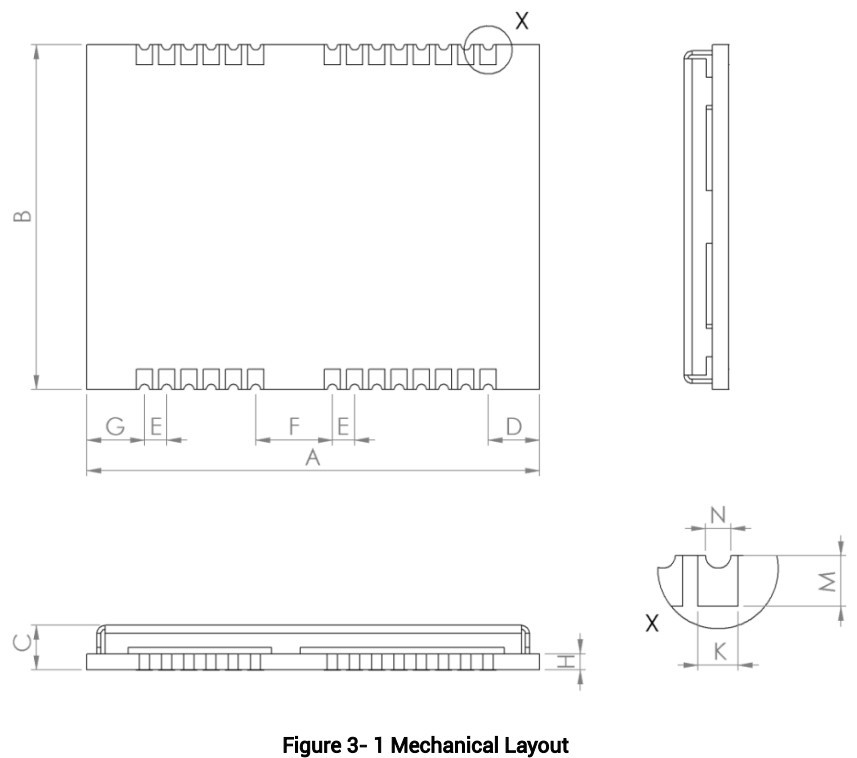
3.4 Pin Definition
 Table 3- 4 Pin Definition
Table 3- 4 Pin Definition
| No | Name | I/O | Electrical Level | Description |
| 1 | TXD2 | O | LVTTL | COM2 is for data transmission. Firmware upgrade is not supported. Leave this pin floating if idle. |
| 2 | RXD2 | I | LVTTL | COM2 is for data transmission. Firmware upgrade is not supported. Leave this pin floating if idle. |
| 3 | TXD1 | O | LVTTL | COM1 is for data transmission. Firmware upgrade is supported. |
| 4 | RXD1 | I | LVTTL | COM1 is for data transmission. Firmware upgrade is supported. |
| 5 | NC | |||
| 6 | VCC | I | 3.0V~3.6V | Power supply |
| 7 | GND | Ground | ||
| 8 | VCC_OUT | O | 3.0V~3.6V | Power supply output, leave this pin floating if idle |
| 9 | NC | |||
| 10 | nRESET | I | LVTTL | External Reset Pin, low active |
| 11 | V_BCKP | I | When the main power supply VCC of the module is cut off, V_BCKP supplies power to RTC and SRAM; Current value is about 50μA. V_BCKP is necessary for hot start. If you do not use the hot start function, connect V_BCKP to VCC. Do NOT leave it floating or connect it to ground. |
|
| 12 | NC | |||
| 13 | GND | — | Ground | |
| 14 | GND | — | Ground | |
| 15 | GND | — | Ground | |
| 16 | RF_IN | I | GNSS signal input | |
| 17 | GND | — | Ground | |
| 18 | VCC_RF | O | RF power supply output, leave this pin floating if idle |
|
| 19 | V_ANT | I | Antenna bias voltage, ground this pin if idle | |
| 20 | ANT_DET_N | I | Open circuit detection of the active antenna | |
| 21 | NC | |||
| 22 | NC | |||
| 23 | NC | |||
| 24 | NC | |||
| 25 | NC | |||
| 26 | NC | |||
| 27 | NC | |||
| 28 | TIME PULSE | LVTTL | 1PPS, leave this pin floating if idle |
3.5 PCB Packaging
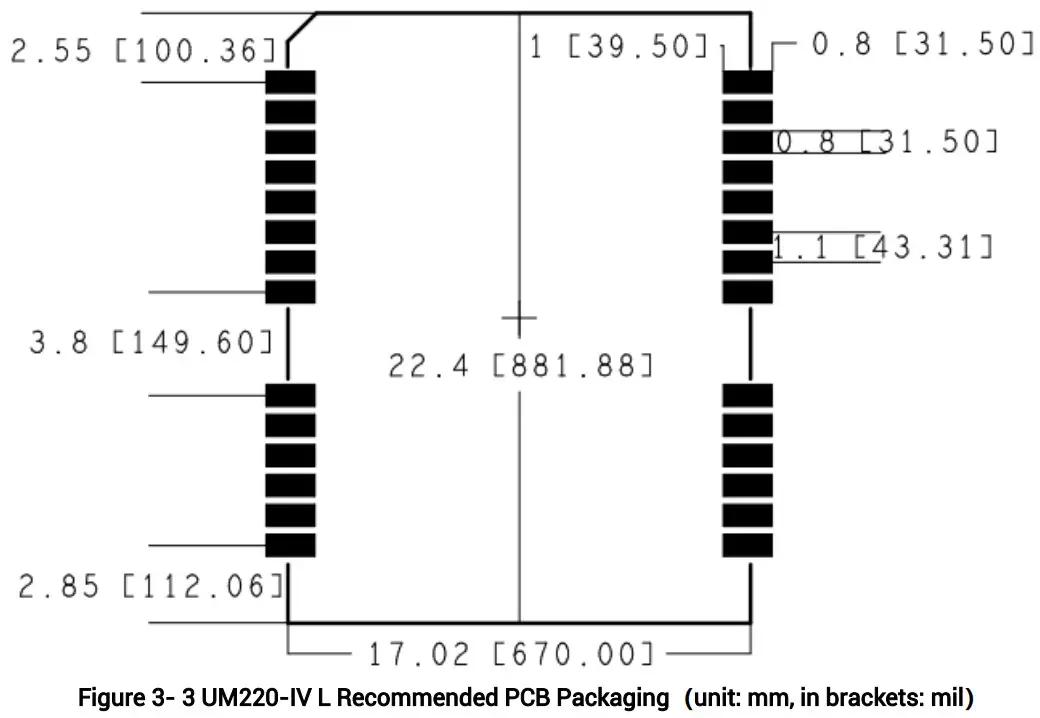
![]() When designing PCB solder mask, make sure that the area under UM220-IV l module is completely coated with solder mask.
When designing PCB solder mask, make sure that the area under UM220-IV l module is completely coated with solder mask.
Hardware Design
4.1 Power Supply
4.1.1 Main Supply (VCC)
The voltage range of VCC is 3.0 V ~ 3.6 V.
Notes:
- The VCC initial level when power-on should be less than 0.4 V.
- The VCC ramp when power-on should be monotonic, without plateaus.
- The voltages of undershoot and ringing should be within 5% VCC.
- VCC power-on waveform: The time interval from 10% rising to 90% must be within 100 μs ~ 10 ms.
- Power-on time interval: The time interval between the power-off (VCC < 0.4 V) to the next power-on is recommended to be larger than 500 ms.
4.1.2 Backup Supply (V_BCKP)
If the hot start function is needed, users should supply backup power to the module. The voltage range of V_BCKP is 1.65 V ~ 3.6 V.
Notes:
- The V_BCKP initial level when power-on should be less than 0.4 V.
- The V_BCKP ramp when power-on should be monotonic, without plateaus.
- The voltages of undershoot and ringing should be within 5% V_BCKP.
- V_BCKP power-on waveform: The time interval from 10% rising to 90% must be within 100 μs ~ 10 ms.
- Power-on time interval: The time interval between the power-off (V_BCKP < 0.4 V) to the next power-on is recommended to be larger than 500 ms.
- The V_BCKP pin cannot be floating or connected to ground. When V_BCKP is not used, it should be connected to VCC or connected to backup power.
4.2 Antenna Design
4.2.1 Passive Antenna
The RF input port of the module can be connected directly to the RF_IN without providing a DC voltage. There are a few things to note when using a passive antenna:
- Select a proper installation position of the antenna to reduce the interference of electromagnetic noise, so as to enable the optimum performance of the antenna;
- A 50 impedance match of RF link is needed;
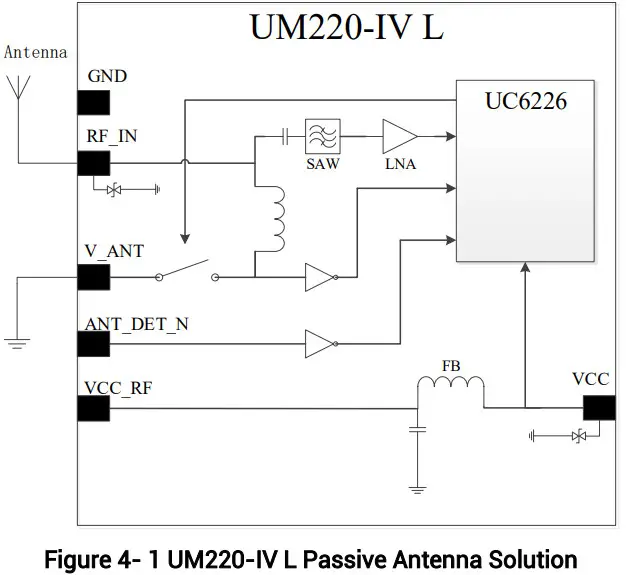
To improve the performance of RF analog front-end, a low noise amplifier (LNA) can be added behind the passive antenna. UM220-IV L module provides a 3.3V power supply (VCC_RF) for LNA.
Note: If the user has a high requirement for ESD (higher than the maximum specification in User Manual), the user should consider other method to power the LNA rather than using the VCC_RF pin. In this case, it is recommended to choose a power supply chip with high ESD protection level. Gas discharge tube, varistor, TVS tube and other high-power protective devices may also be used in the power supply circuit to further protect the module from ESD damage or other Electrical Over-Stress (EOS). 4.2.2 Active Antenna
4.2.2 Active Antenna
The active antenna increases the system power consumption when improving the system performance. The 3.3V Power Supply (VCC_RF) provided by the UM220-IV l module can be used to power the antenna directly if the function of detecting the state of the antenna inside the module is not used and the working voltage of the antenna is 3.3V.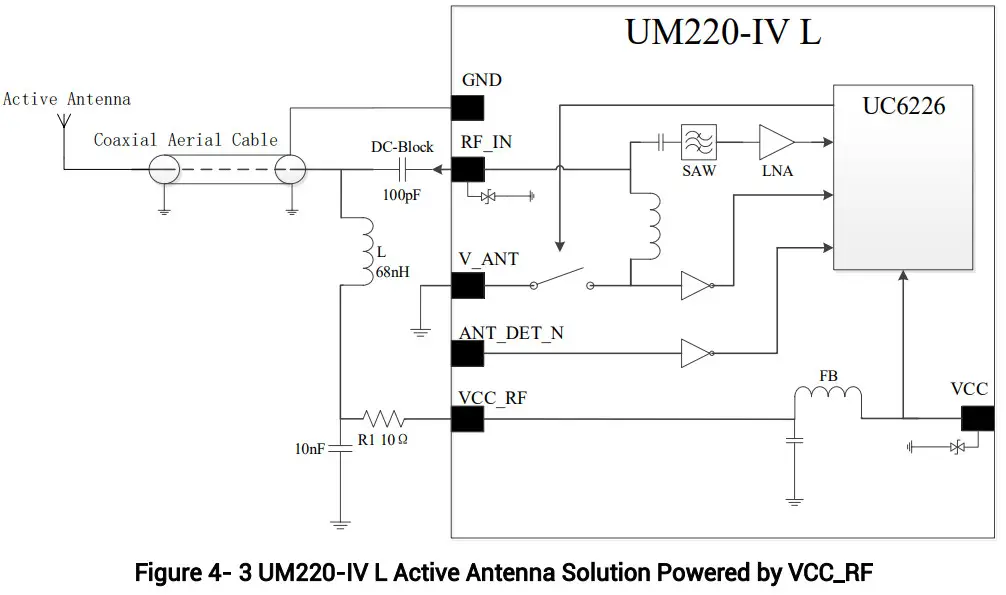
![]() If the user has a high requirement for ESD (higher than the maximum specification in User Manual), the user should consider other method to feed the antenna rather than using the VCC_RF pin. In this case, it is recommended to choose a power supply chip with high ESD protection level. Gas discharge tube, varistor, TVS tube and other high-power protective devices may also be used in the power supply circuit to further protect the module from ESD damage or other Electrical Over-Stress (EOS).
If the user has a high requirement for ESD (higher than the maximum specification in User Manual), the user should consider other method to feed the antenna rather than using the VCC_RF pin. In this case, it is recommended to choose a power supply chip with high ESD protection level. Gas discharge tube, varistor, TVS tube and other high-power protective devices may also be used in the power supply circuit to further protect the module from ESD damage or other Electrical Over-Stress (EOS).
When the working voltage of the active antenna is not 3.3V, the antenna can be powered by the external power supply.
![]() If the antenna power supply and the module’s main supply VCC use the same power rail, the ESD, surge and overvoltage from the antenna will have an effect on VCC, which may cause damage to the module. Therefore, it’s recommended to design an independent power rail for the antenna to reduce the possibility of damage to the module.
If the antenna power supply and the module’s main supply VCC use the same power rail, the ESD, surge and overvoltage from the antenna will have an effect on VCC, which may cause damage to the module. Therefore, it’s recommended to design an independent power rail for the antenna to reduce the possibility of damage to the module.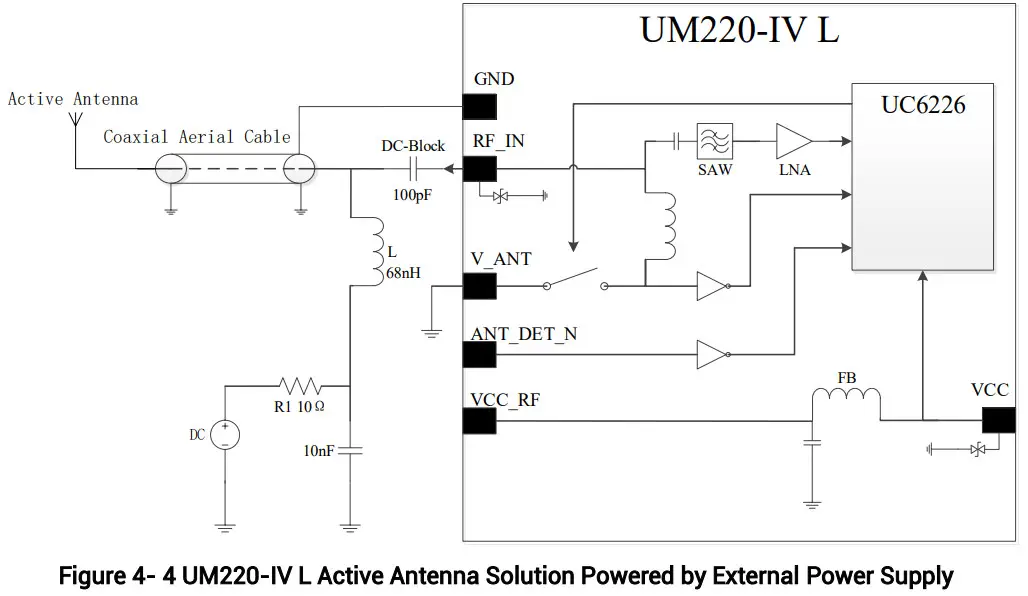 4.2.3 Active Antenna State Detection
4.2.3 Active Antenna State Detection
UM220-IV L module can detect the active antenna state including open-circuit, shortcircuit and normal state. The host computer enables or disables the antenna state detection function by transmitting commands via serial ports, and receives the detected antenna state via serial ports. The module cuts off the power supply automatically when detecting the short-circuit state of antenna.
- Antenna Short-circuit Detection
If the antenna short-circuit detection function is required, connect the antenna power supply to the module’s V_ANT Pin after cascading an appropriate value of resistance, and feed the antenna through the internal switch. If the V_ANT pin is directly connected without a serial resistor, the module will be damaged when the antenna is shortcircuited. The internal switch is turned off by default, which can be switched with the CFGANT command. When the module detects an antenna short-circuit, the antenna feed is cut off immediately through the internal switch, periodically feeds the antenna and detects the state. Use ANTSTAT for the query.
If the working voltage of the antenna is 3.3V, the 3.3V power supply (VCC_RF) provided by the module can be connected in series with a 10Ω resistor to the V_ANT pin, and turn on the internal switch through CFGANT to power the antenna. If an antenna short circuit is detected at this time, the module will automatically turn off the switch. When there is a need to save the power consumption, turn off the switch through CFGANT.
 Refer to UM220-IV L_ Protocol Specification for more details
Refer to UM220-IV L_ Protocol Specification for more details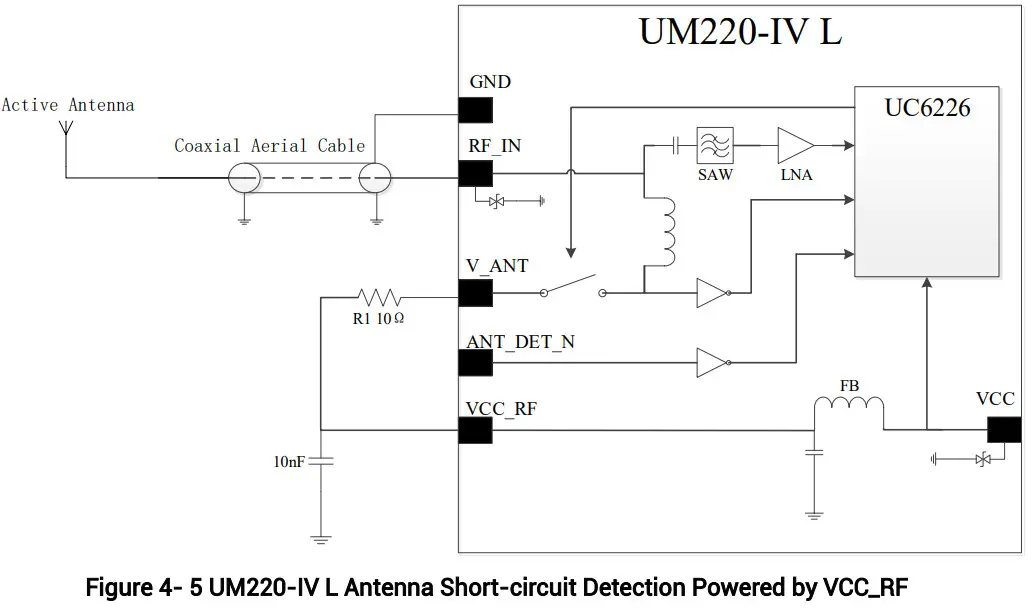 When the working voltage of the antenna is 5V, the antenna can be powered by connecting an external power supply with a 10Ω serial resistor to the V_ANT pin. Since this power supply is directly connected to the RF_IN pin of the module, this power
When the working voltage of the antenna is 5V, the antenna can be powered by connecting an external power supply with a 10Ω serial resistor to the V_ANT pin. Since this power supply is directly connected to the RF_IN pin of the module, this power
supply cannot introduce noise. It’s recommended to use the power supply from analog network.
- Antenna Short-circuit and Open-circuit Detection
If the short-circuit and open-circuit detection functions of the module are required concurrently, use the ANT_DET_N pin to cooperate with an external circuit. The threshold current for open circuit detection can be calculated by formula (4-1). When the antenna working current is less than the calculated value, the module determines that the antenna is open-circuit. The resistance of the series resistor R1 can be adjusted according to the antenna working current.

![]() If an external power supply is used to power the antenna, the maximum power supply voltage cannot exceed 5.5V to protect the ANT_DET_N pin.
If an external power supply is used to power the antenna, the maximum power supply voltage cannot exceed 5.5V to protect the ANT_DET_N pin.
Use ANTSTAT to query the antenna state.
4.3 UART
The two serial ports of UM220-IV L are LVTTL levels, which need to be converted through RS232 level if connected to PC. 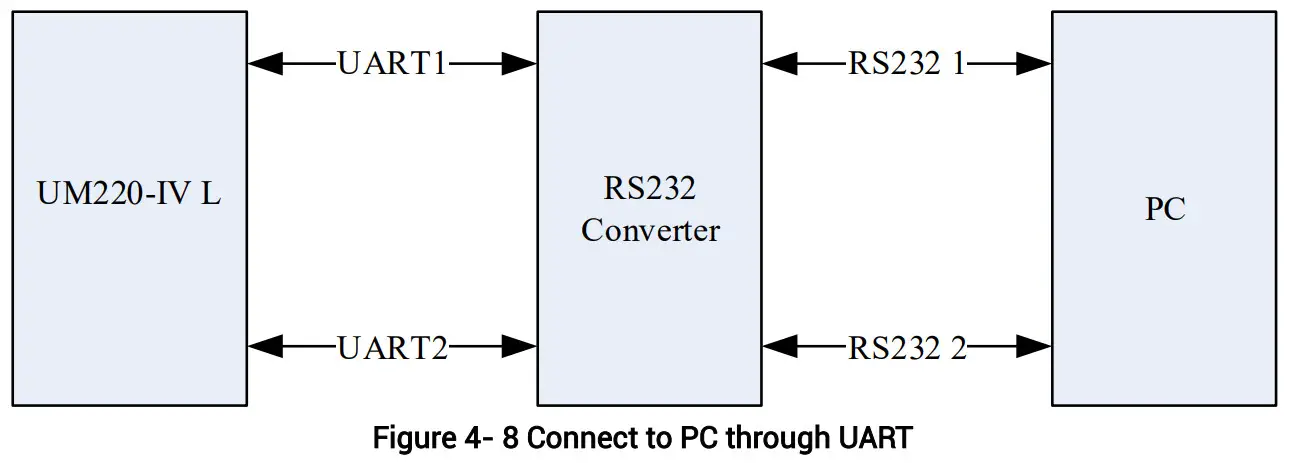 It is recommended that users reserve a test point for serial port 2 as the debug port.
It is recommended that users reserve a test point for serial port 2 as the debug port.
![]() If there is data input on the module input ports (RXD, GPIO) when the module is not powered on, it will form power leakage on the module VCC. When the leakage voltage is higher than 1.6V, it may cause a start failure when the module is powered on. To prevent the leakage power, ensure that the IO port connected to the module is in high impedance or low level when the module is not powered on.
If there is data input on the module input ports (RXD, GPIO) when the module is not powered on, it will form power leakage on the module VCC. When the leakage voltage is higher than 1.6V, it may cause a start failure when the module is powered on. To prevent the leakage power, ensure that the IO port connected to the module is in high impedance or low level when the module is not powered on.
4.4 RESET Time Sequence
There is a reset chip inside the module. When VCC is lower than 2.63V (typical value of ambient temperature) or nRESET is at low level, the module is in reset state. After VCC rises to 2.63V or nRESET changes from low to high, the reset state of the chip will continue to remain for 200ms.
It is recommended to keep the reset signal of the nRESET pin for 10ms after VCC is valid at power-up. During normal operation, the minimum valid time of the reset signal for the nRESET pin is 500ns.
4.5 TIME PULSE Output
The period of the TIME PULSE output signal is 1s, the peak-to-peak value is VCC, and the default duty cycle is 10%.
4.6 Layout Recommendation
- Power supply: Stable and low ripple power is necessary for good performance.
Make sure the peak-to-peak voltage ripple does not exceed 50mV.
− Use LDO to ensure the purity of power supply;
− Place LDO to the module as close as possible in layout;
− Widen the power circuit wiring or use split copper surface to transmit current;
− Avoid the high–power or high inductance devices such as magnetic coil. - Antenna interface: note with the antenna impedance matching, and the circuit is short and smooth, try to avoid acute angles.
- Connect the RF signal to the antenna and make sure the 50 Ω impedance match on the circuit.
- Antenna location: to obtain a good signal-to-noise ratio, ensure that the antenna is well isolated from electromagnetic radiation sources, especially electromagnetic radiation in the frequency range of 1559 to 1605 MHz.
- Try to avoid circuits below the UM220-IV L module.
- UM220-IV L module is a temperature sensitive device, rapid temperature changes will result in reduced performance. Keep it as far away from the highpower high-temperature air and heating devices as possible.
Packaging
5.1 Product Labeling

5.2 Packaging Description
UM220-IV L modules use carrier tape and reel (suitable for mainstream surface mount equipment), packaged in vacuum-sealed aluminum foil antistatic bags, with a desiccant inside to prevent moisture. When using reflow welding process to weld modules, please strictly comply with IPC standard to conduct humidity control on modules. As packaging materials such as carrier belt can only withstand the temperature of 65 degrees Celsius, modules shall be removed from the packaging during baking.
Table 5- 1 Package Instructions
| Item | Description |
| Module | 500 pics/reel |
| Reel size | Tray: 13″ external diameter: 330mm, internal diameter: 100mm, width: 24mm thickness: 2.0mm |
| Carrier tape | Space between: 20mm |
UM220-IV L module is rated at MSL level 3, refer to the relevant IPC/JEDEC standards for baking requirements. Please access to the website www.jedec.org to download for details.
The shelf life of UM220-IV L module is one year.
Soldering and Disassembly
6.1 Disassembly
When it is necessary to remove the module, it is recommended to melt the soldering tin of the pins on both sides of the module with an electric soldering iron and remove the module with tweezers. Do NOT use other means to remove the module (for example, the module is blown off by a hot air gun), which may lead to module damage.
6.2 Clean
Do NOT use alcohol or other organic solvents to clean, it may lead to flux residues into the shielding shell, causing mildew and other problems
6.3 Reflow Soldering
In order to avoid component falling off, the module should be placed on the upper part of the motherboard when soldering. The reflow temperature curve is recommended as shown in figure 6-1 below (M705-GRN360 is recommended for solder paste).
Note: The module can only be soldered once.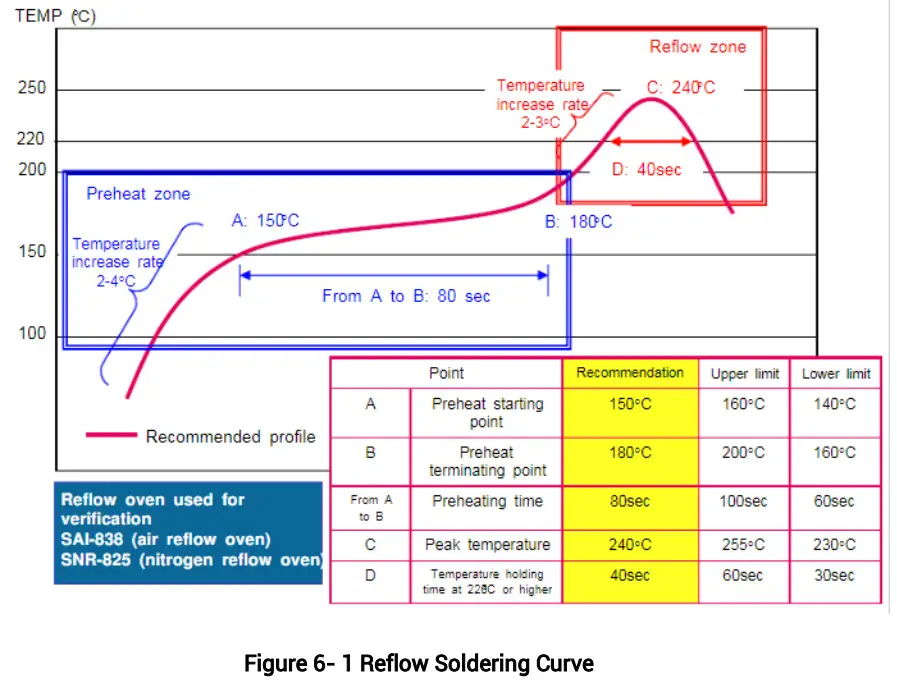
 Unicore Communications, Inc.
Unicore Communications, Inc.
F3, No.7, Fengxian East Road, Haidian, Beijing, P.R.China,
100094
www.unicorecomm.com
Phone: 86-10-69939800
Fax: 86-10-69939888
info@unicorecomm.com
Documents / Resources
 |
unicore UM220-IV L Single Frequency Multi GNSS Timing Module [pdf] User Manual UM220-IV L Single Frequency Multi GNSS Timing Module, UM220-IV L, Single Frequency Multi GNSS Timing Module, Multi GNSS Timing Module, GNSS Timing Module, Timing Module |